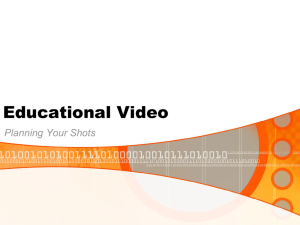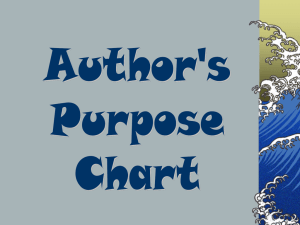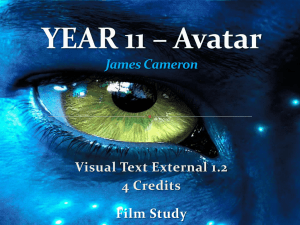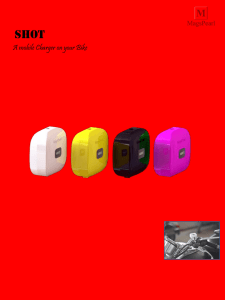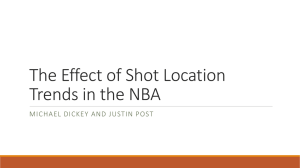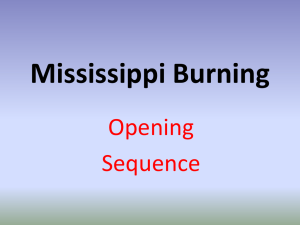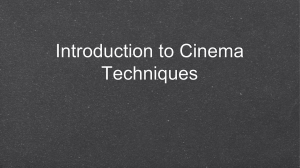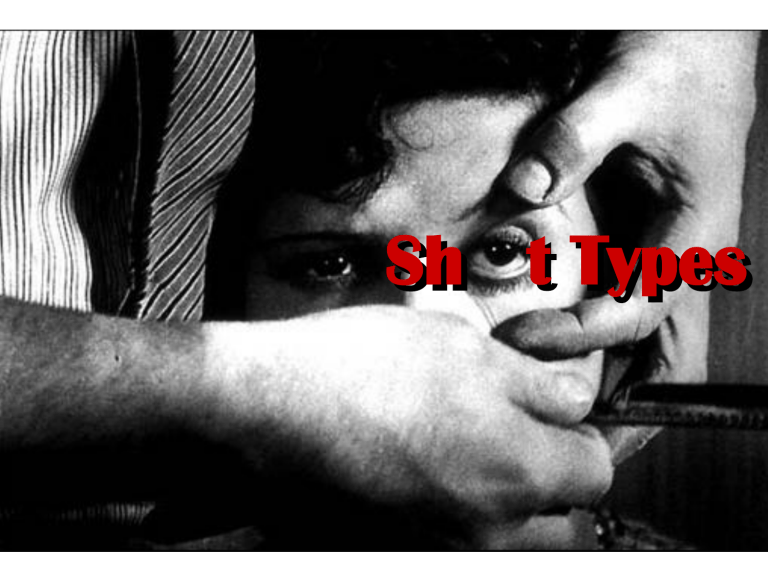
Sh t Types
Establishing Shots
Establishing shots set up a scene’s
location and/ or its participants.
• The following shot is the very first frame of
The Conversation and it’s an example of
how establishing shots can often start in
a title sequence.
The next establishing shot is from
The Godfather part II. It illustrates
how an establishing shot can
establish both the location and tone
of the following scenes.
Next is an example of how an
establishing shot can be
supported by a caption. This is
taken from the opening of Alien
and the caption helps exposition.
Not all establishing shots are
long shots. In this case the in car
mid-shot that opens Scum creates
a sense of tension that increases
when we see they’re prison officers
chasing a prisoner.
This establishing shot from All
About Eve happens late in the film
and shifts location and time. The
bed, clock and lighting suggest
morning, the phone centre frame
sets up expectation.
Extreme Long Shot
The extreme long-shot (sometimes called
a wide-shot) has a variety of functions. In
this scene from Alien it shows the vastness
of the ship and makes the characters seem
vulnerable. The effect is made greater by
the number of claustrophobic mid-shots
and close-ups that precede it.
Lawrence of Arabia has some of
cinema’s most famous extreme
long shots.
Long Shot
Long-Shot
A long-shot should show a whole figure or
a large section of location. Long-shots
often feature movement because static
figures in a long-shot can seem
confrontational. You’ll see lots of static
figure long-shots in horror and sci-fi. The
next shot is from a parody of these genres,
Weird Science.
Film makers will often break up a two-shot
by adding another plane. In this shot from All
About Eve the mid-shot is supported by
another figure in long-shot.
Mid-shot
The Mid-shot is the most common shot
used, especially on television. The Mid-shot
will show most of a figure but will show
location too so is a popular choice for the
two-shot.
Mid-shots are a good choice for shot –
reverse – shots and scenes involving a
dialogue. Take a look at the video extract
from Heat.
Mid-shots can be side on as well as straight
on. This mid-shot from Withnail and I
suggests a real sense of unity between the
two characters that could be lost if the
camera was directly in front of them.
Medium close-up
The medium close-up can be defined
as head and shoulders. Medium
close-ups are more intimate than the
mid-shot as this shot from
Breathless illustrates. In the video
extract from Heat you can see the
shot-reverse-shots go from midshot to medium close-up as the
conversation becomes more intimate
and tension builds.
Over the shoulder shots are often medium close-ups as is seen in this
shot from Peeping Tom. A medium close-up allows the viewer to see a
greater depth of emotion on the actor’s face.
In this shot from Bus Stop you get an over the shoulder,
medium close-up, 4 shot through a reflection. This allows
us to see the map and the reaction to it.
Close-up
The close-up lets us see emotion and reactions on actor’s faces that
could be missed. Very often close-ups will be a cutaway from a wider
shot.
Close-ups can also isolate important elements of mise-enscene. In this cutaway shot from The Conversation the
close-up of the three locks show the character’s paranoia.
The drama of a close-up can be enhanced by an unusual
angle.
Extreme Close-up
Extreme close-ups are very tight so that only part
of an object or person can be seen.
The Point of View shot (POV) is a type of cutaway that
shows what a character is seeing, it’s often part of a shot –
reverse – shot.
Sometimes a filter will be used to make a point of
view shot more obvious. In this example from
Peeping Tom it’s a viewfinder.
Composition
Bilateral symmetry positions characters or objects equally on
either side of the frame. It looks constructed and can be very
dramatic.
The following shot from Peter Pan shows how strong composition adds drama.
Deep Focus
Deep focus involves a large depth of field
where every plane is in focus. It involves
careful control of light and lenses so isn’t
that common in film but is becoming more
common with digital technology. The
following shot from Citizen Kane shows
four planes all in focus.
Camera Angles
A range of effects can be gained by
changing angles. In the next shot from
Gone with the Wind the male figure is
seen as dominant over the female
because of the low angle. As she is in the
foreground the low angle has most effect
on his position in the frame.
This high angle shot from the same film
makes him seem small and it emphasises
the expectation of the central female
character’s entrance at the top of the
stairs.
This low-angle shot from Mad Max gives the
character authority and power. Low-angle shots
don’t always connote power though. The following
shot from Old Boy has a very different effect.
Sometimes the frame can be canted, on an
angle. This is sometimes referred to as a
Dutch Tilt. It’s very common in Film Noir
and creates a sense of tension and unease.
The following shot is from The Third Man,
its director, Orson Welles, pretty much
defined Noir visual style in films like Citizen
Kane.



